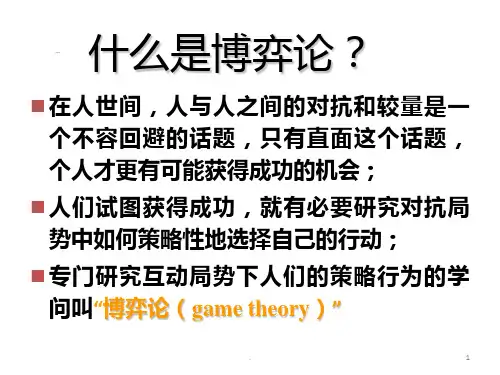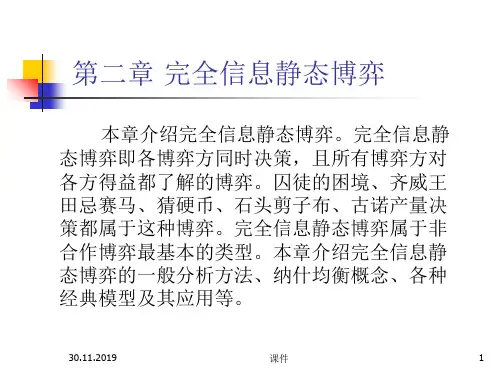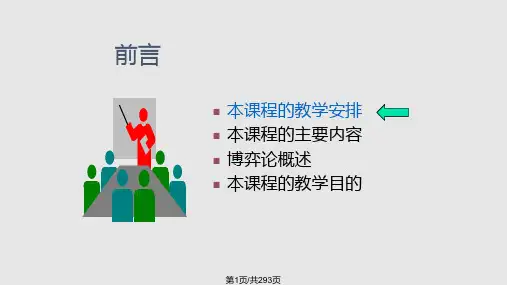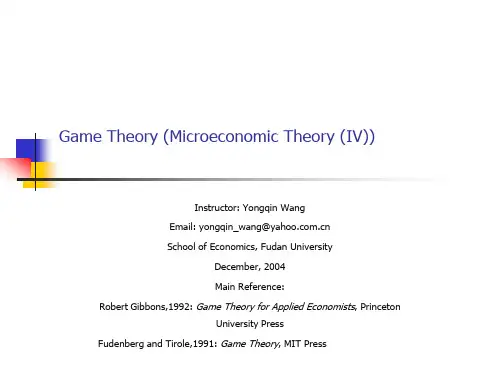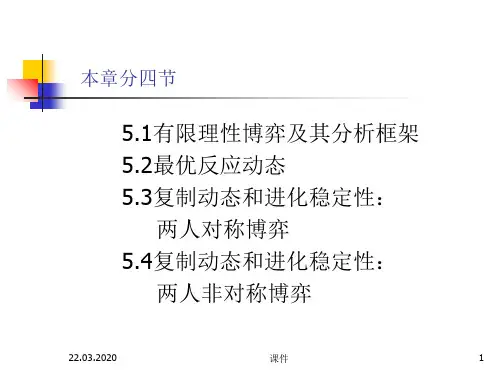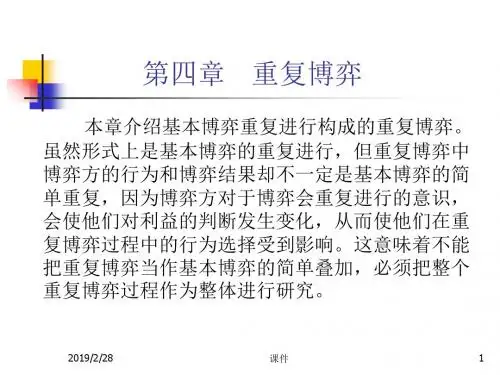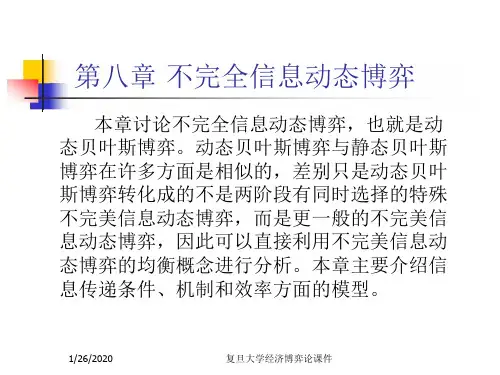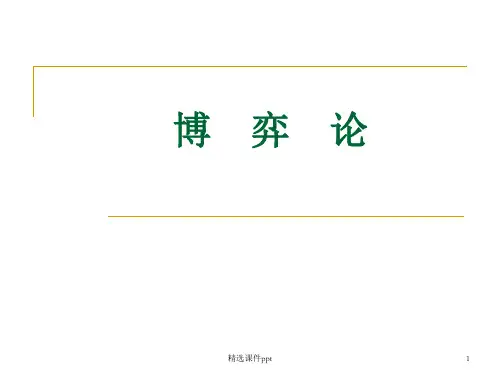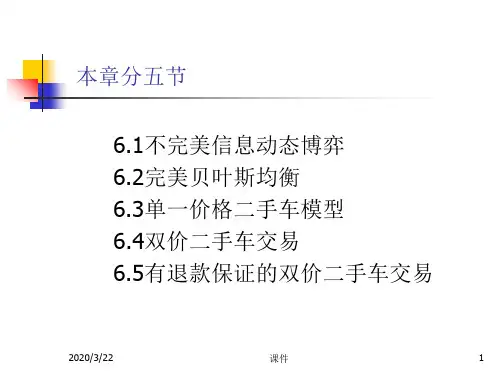- 1、下载文档前请自行甄别文档内容的完整性,平台不提供额外的编辑、内容补充、找答案等附加服务。
- 2、"仅部分预览"的文档,不可在线预览部分如存在完整性等问题,可反馈申请退款(可完整预览的文档不适用该条件!)。
- 3、如文档侵犯您的权益,请联系客服反馈,我们会尽快为您处理(人工客服工作时间:9:00-18:30)。
iterated elimination of strictly dominated strategies.
1.3.2 Existence of NE
Theorem (Nash, 1950): In the n -player normal form game
G {S1,..., Sn;u1,...,un}
1.4 Applications 1.4.1 Cournot Model
Two firms A and B quantity compete.
Inverse demand function P a Q, a 0
They have the same constant marginal cost, and there is no fixed cost.
q2*
R2 (q1)
a
q1 2
c
(provided that q1 a c ).
Cont’d
Now, firm 1’s problem
q1 arg max 1(q1, R2 (q1)) q1[a q1 R2 (q1) c]
q1*
a
2
c
so,
q2*
a
4
c
.
Cont’d
Compare with the Cournot model. Having more information may be a bad thing
Cont’d
A maximum number of goats : Gmax : v(G) 0 ,
for G Gmax but v(G) 0 for G Gmax
Also v '(G) 0, v ''(G) 0
The villagers’ problem is simultaneously choosing how many
(
g1*
,
...,
gi*1,
g* i 1
,
g
* n
)
Cont’d
First order condition (FOC):
v(gi
g * i
)
giv
'( gi
g
*
i
)
c
0
(2)
(where
g*i
g1*
...
g* i 1
g* i 1
...
gn*
)
Summing up all n farmers’ FOC and then dividing by n yields
2.1.A Theory: Backward Induction Example: The Trust Game
General features:
(1) Player 1 chooses an action a1 from the feasible set A1 . (2) Player 2 observes a1 and then chooses an action a2 from
c is the constant marginal cost of production (fixed cost being zero).
Cont’d
We solve this game with backward induction
q2 arg max 2 (q1, q2 ) q2 (a q1 q2 c)
if n is finite and S i is finite for every i , then there exist at
least one NE, possibly involving mixed strategies.
See Fudenberg and Tirole (1991) for a rigorous proof.
are a NE, if for each player i,
si* is (at least tied for) player i’s best response to the strategies
specified for the n-1 other players,
( s1* , ...,
s* i 1
strategies are the unique NE of the game.
A Formal Definition of NE
In the n-player normal form G {S1,..., Sn ;u1,...,un}
the strategies (s1*,..., sn* )
Proposition A In the n -player normal form game
G {S1,..., Sn ; u1,..., un}
if iterated elimination of strictly dominated strategies
eliminates all but the strategies (s1*,..., sn* ) , then these
the feasible set A2 .
(3) Payoffs are u1(a1, a2 ) and u2 (a1, a2 ) .
Cont’d Backward Induction:
a2 arg max u2 (a1, a2 ) Then a1 arg max u1(a1, R2 (a1))
G* G**
Implications for social and economic systems (Coase Theorem)
2. Dynamic Games of Complete Information
2.1 Dynamic Games of Complete and Perfect Information
n Exercise: Extend the analysis to firm case.
2.2 Two stage games of complete but imperfect information 2.2.A Theory: Sub-Game Perfection
Here the information set is not a singleton.
Consider following games
(1)Players 1 and 2 simultaneously choose actions a1 and a2
from feasible sets A1 and A2, respectively.
(2) Players 3 and 4 observe the outcome of the first stage
v(G*) 1 G*v '(G*) c 0 (3) n
Cont’d
In contrast, the social optimum G** should resolve
max Gv(G) Gc
FOC:
v(G**) G**v'(G**) c 0
(4)
Comparing (3) and (4), we can see that
Hardin(1968) : The Tragedy of Commons
Cont’d
There are n farmers in a village. They all graze their goat on the
village green. Denote the number of goats the ith farmer owns
“People think backwards”
2.1.B An example: Stackelberg Model of Duopoly
Two firms quantity compete sequentially.
Timing: (1) Firm 1 chooses a quantity q1 0 ;
Game Theory (Microeconomic Theory (IV))
Instructor: Yongqin Wang Email: yongqin_wang@ School of Economics, Fudan University
December, 2004 Main Reference: Robert Gibbons,1992: Game Theory for Applied Economists, Princeton University Press Fudenberg and Tirole,1991: Game Theory, MIT Press
competing firms? (Convergence to Competitive Equilibrium)
1.4.2 The problem of Commons
David Hume (1739): if people respond only to private incentives, public goods will be underprovided and public resources overutilized.
1 and 2 anticipate the second behavior of 3 and 4 will be given by
q (2) Firm 2 observes 1 and then chooses a quantity q2 0 ;
i (3) The payoff to firm is given by the profit function
i (qi , q j ) qi[P(Q) c]
P(Q) a Q is the inverse demand function, Q q1 q2 , and
by gi , and the total number of goats in the village by G g1 ... gn
